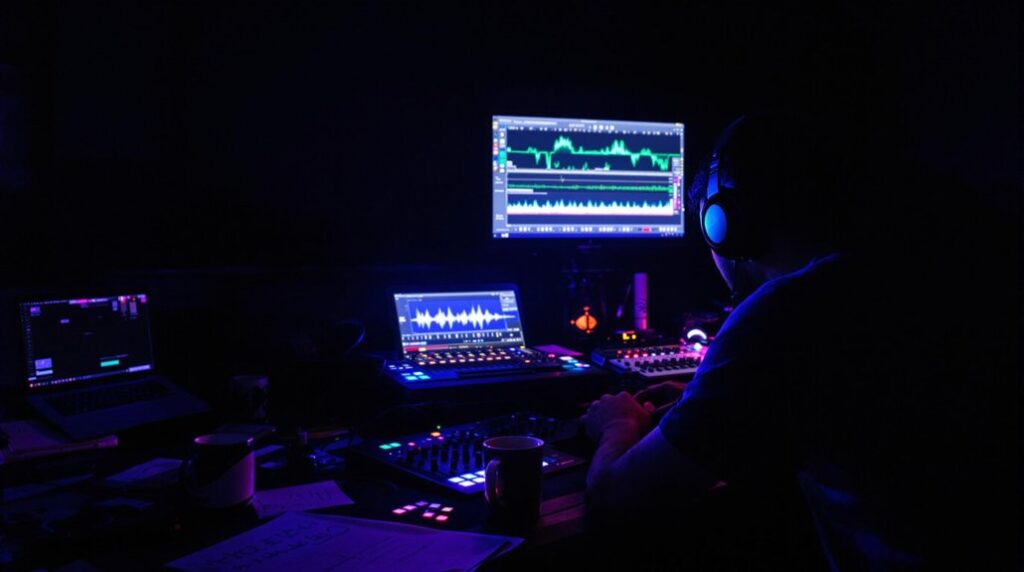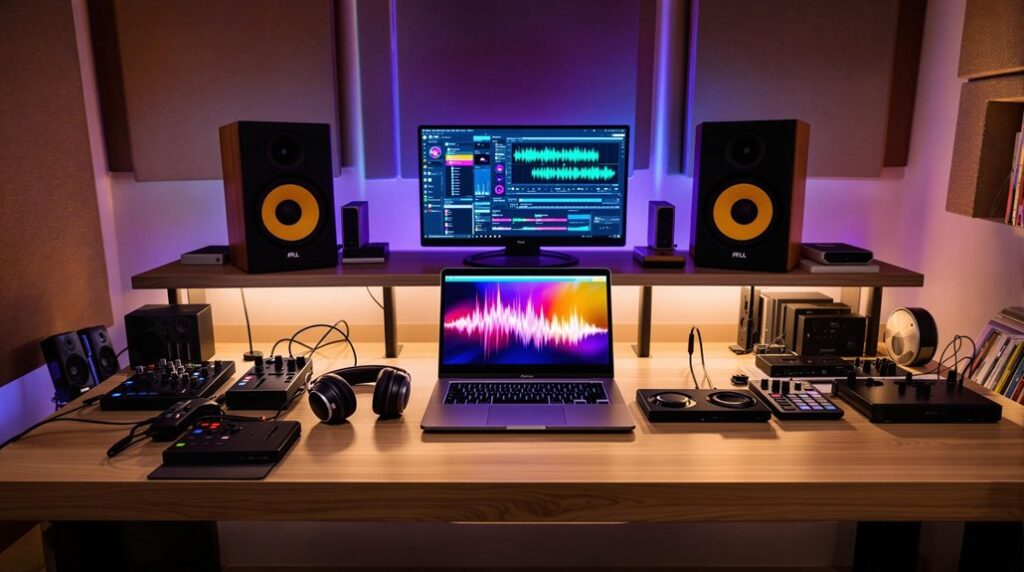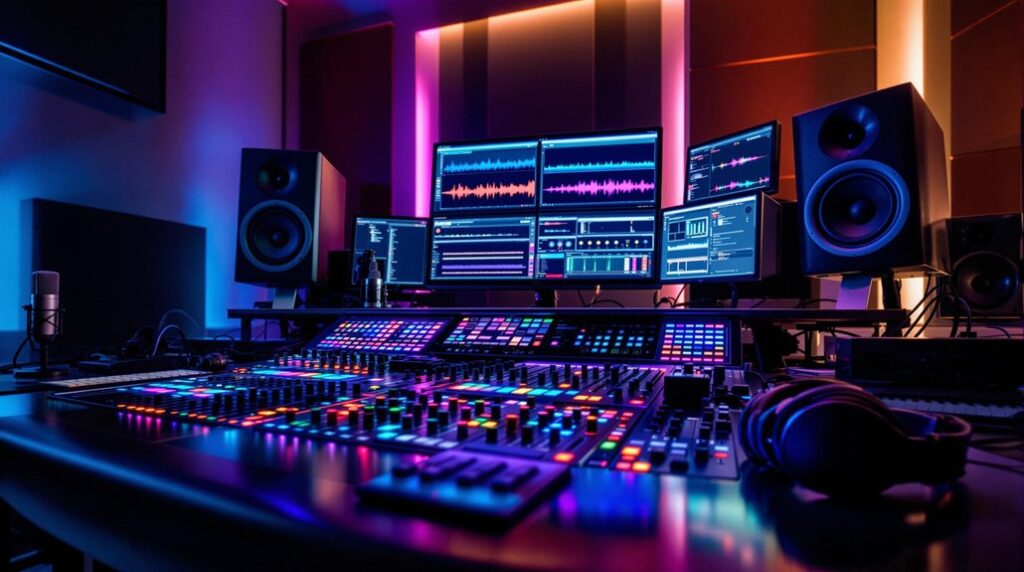Mastering advanced EQ techniques is crucial for achieving the perfect sound. Start by understanding EQ basics, manipulating frequency bands from 20Hz to 20kHz. Utilize mid/side EQ techniques to enhance spatial clarity, boosting high frequencies in the side channel and narrowing mid frequencies in the mid channel. Dynamic EQ helps tackle real-time signal fluctuations, while spectral matching aligns your mix with professional standards. Subtractive EQ methods, like frequency notching and precision cutting, can eliminate unwanted noise and resonance. To achieve a clean mix, EQ effects returns by managing frequency balance. Master these strategies for a polished, professional sound that stands out.
Key Takeaways
- Use dynamic EQ to manage real-time frequency fluctuations and target specific frequencies dynamically for nuanced mastering.
- Apply mid/side EQ techniques to enhance stereo width and spatial clarity by focusing on side channel frequencies.
- Implement subtractive EQ methods to eliminate problematic frequencies, reduce muddiness, and enhance overall mix clarity.
- Utilize spectral matching to align your mix’s frequency distribution with a reference track for professional tonal balance.
- Employ high-pass filters on effects returns to remove unnecessary low frequencies and prevent rumble for a cleaner mix.
Understanding EQ Basics
Understanding EQ basics is essential for anyone looking to master audio manipulation, as it involves adjusting specific frequency bands to achieve a balanced and refined sound. To start with, EQ, or equalization, focuses on frequency modulation to sculpt sound. By manipulating frequencies, you can enhance or reduce elements like bass, midrange, and treble, achieving precise tonal shaping for audio clarity.
The frequency spectrum spans from sub-bass (20Hz to 50Hz) to high frequencies (10kHz to 20kHz), each contributing uniquely to the overall sound. Human ears can detect a broad range of 20Hz to 20kHz, but for audio precision, the important frequencies often lie between 60Hz and 4kHz. These are the frequencies that most impact the clarity and presence of the sound.
Decibels (dB) measure volume levels, and even small adjustments can greatly affect how sound is perceived. Graphical EQ displays are invaluable here, showing frequencies versus decibels, which allows for meticulous adjustment of each band. This precision in tonal shaping ensures that each element in the audio mix is balanced and refined, enhancing the overall sound quality.
Essentially, mastering EQ basics lays the foundation for advanced sound sculpting techniques.
Mid/Side EQ Techniques
To balance your stereo image using Mid/Side EQ techniques, you can start by boosting high frequencies in the side channel. This helps enhance spatial clarity.
Narrowing mid frequencies in the mid channel can provide more focus and punch to your mix.
Additionally, applying a high-pass filter to the bass frequencies in the mid channel will secure a solid, mono low-end foundation.
Balancing Stereo Image
Mastering Mid/Side EQ techniques can greatly enhance your stereo image by allowing you to fine-tune specific frequencies in the mid and side channels, creating a more dynamic and immersive sound.
By focusing on the side channel, you can improve stereo width and frequency balance. Boosting high frequencies in the side channel adds clarity and dimension, enhancing the spatial depth of your mix. Conversely, narrowing mid frequencies sharpens the focus and punch at the center, ensuring phase coherence.
To achieve a balanced stereo image, start by high-passing bass frequencies in the side channel. This step collapses low-end content to mono, resulting in a tighter, more controlled bass response.
Next, apply subtle boosts to the high frequencies in the side channel to create a sense of air and openness. This approach not only widens your stereo field but also maintains frequency balance across the spectrum.
Additionally, slight attenuation of mid frequencies in the mid channel can prevent overcrowding, allowing each element to occupy its own space. By methodically adjusting these parameters, you can sculpt a mix with enhanced stereo width, an ideal spatial depth, and impeccable phase coherence, delivering a polished and professional sound.
Enhancing Spatial Clarity
Achieving enhanced spatial clarity with Mid/Side EQ techniques involves strategically adjusting frequency content in both the mid and side channels to create a more defined and immersive soundstage. By separating mono and stereo elements, you can manipulate the stereo field to achieve superior spatial imaging.
Begin by boosting high frequencies in the side channel. This enhances stereo widening, making the mix feel more open and expansive.
Next, narrow the mid frequencies in the center channel. This step creates focus and punch, allowing key elements like vocals and lead instruments to stand out clearly.
To maintain a clean, powerful low end, apply a high-pass filter to bass frequencies in the side channel. This effectively collapses the bass to mono, preventing phase issues and ensuring a solid foundation even when played back on systems with limited stereo capabilities.
Mid/Side EQ is particularly effective when processing the side channel. By enhancing spatial imaging, it accentuates the contrast between central and peripheral elements, giving your mix a professional, polished sound.
Dynamic EQ Strategies
Often, dynamic EQ strategies rely on the ability to intricately manage frequency bands in response to real-time signal fluctuations, guaranteeing precise and adaptive control over the audio spectrum. Dynamic EQ applications allow you to address mastering nuances by targeting specific frequencies dynamically, adjusting them as the signal changes. This is particularly useful for tasks like de-essing vocals, where sibilant sounds need reduction without dulling the overall vocal clarity. Additionally, dynamic EQ excels in taming harsh frequencies, addressing resonant peaks, and cleaning up audio issues that static EQs might miss.
Creative dynamic EQ uses enable advanced sound sculpting techniques. You can shape your audio with surgical precision, making subtle yet impactful changes. For instance, if a guitar track has occasional harsh high frequencies, a dynamic EQ can selectively reduce those peaks only when they occur, preserving the instrument’s natural tone. This adaptive approach ensures that your mix remains balanced and natural-sounding.
Dynamic EQ functions similarly to a multi-band compressor but offers more flexibility by dynamically altering the gain of each band. This allows for a targeted approach to EQ adjustments, providing a level of control that’s both subtle and effective.
Spectral Matching
When engaging in spectral matching, you start by analyzing reference tracks to understand their frequency distribution.
This analysis allows you to match the tonal balance of your own mix, ensuring it aligns with professional standards.
Analyzing Reference Tracks
To effectively utilize spectral matching, you need to meticulously analyze the frequency spectrum of your reference track, focusing on identifying key frequency ranges that define its tonal balance. Start with frequency analysis by selecting a reference track that closely resembles the sound you aim to achieve. This step is vital in guaranteeing that your comparisons are meaningful and yield productive results.
When considering track selection, choose a reference track that exemplifies the qualities you desire in your mix, such as clarity, depth, and presence. Use a spectrum analyzer to visualize the frequency distribution, paying close attention to the peaks and valleys. These visual cues will guide you in making precise EQ adjustments.
Reference track considerations should include the genre, instrumentation, and overall production quality. Make sure the reference track is well-mixed and mastered, as this will serve as a reliable benchmark.
Once you’ve gathered your analysis, apply EQ adjustments to your track. Identify areas where your audio’s frequency spectrum diverges from the reference and make targeted changes. Boost or cut specific frequency bands to align your track’s spectral characteristics with the reference. This meticulous process enhances your audio’s overall quality and cohesion, ensuring it stands out in any mix.
Matching Tonal Balance
Immerse yourself in the intricate process of spectral matching by carefully examining your audio’s frequency spectrum against a reference track, guaranteeing each frequency band aligns precisely to achieve a balanced tonal quality. This meticulous analysis is vital for bridging tonal contrast between your mix and the reference, fostering a cohesive auditory experience.
Begin by loading both your audio and the reference track into a spectral analyzer. Observe the frequency content and identify discrepancies. Your goal is to match the frequency alignment, making sure no band is excessively dominant or recessed. This alignment minimizes frequency clashes and creates a harmonious mix.
To achieve precise spectral matching, follow these steps:
- Identify Frequency Discrepancies: Pinpoint where your audio’s spectrum diverges from the reference.
- Apply EQ Adjustments: Use a parametric EQ to adjust the gain of specific frequency bands.
- Reassess Tonal Balance: Continuously compare the adjusted audio to the reference to maintain tonal consistency.
- Refine Dynamics Processing: Ensure your adjustments don’t disrupt the track’s dynamic range.
- Iterate and Fine-Tune: Spectral matching is an iterative process; revisit and refine as necessary.
Subtractive EQ Methods
Subtractive EQ techniques involve meticulously cutting specific frequency ranges to enhance audio clarity, reduce resonances, and eliminate unwanted noise.
One important method is frequency notching, where you target and attenuate problematic frequencies causing resonance issues. This approach, known as resonance control, helps to smooth out your mix by eliminating harsh or boomy tones that can interfere with the overall sound balance.
Precision cutting is another vital aspect of subtractive EQ. By using a high Q factor, you can make narrow cuts that precisely target specific frequencies without affecting the surrounding audio spectrum. This technique is especially useful for clarity enhancement, as it removes unwanted noise and frequencies that muddy the mix.
For example, cutting frequencies in the 300 Hz to 800 Hz range can greatly reduce muddiness and create more space for other elements in the mix.
EQing Effects Returns
When EQing effects returns, it’s essential to shape the reverb and ambience so they blend seamlessly into the mix, enhancing depth and cohesion without overshadowing other elements. By inserting EQ after reverb in software mixing or patching outboard EQ after reverb in hardware setups, you gain precise control over the frequency content and overall impact of the effects.
Reverb sculpting and ambience shaping are vital in achieving a polished sound. Adjustments like midrange dips or low shelf boosts can make a notable difference:
- Midrange Dips: Reducing midrange frequencies can prevent the reverb from becoming muddy and overwhelming.
- Low Shelf Boosts: Enhancing lower frequencies can add warmth and depth, making the reverb sound fuller.
- High-Pass Filtering: Removing unnecessary low frequencies can prevent rumble and clutter in the mix.
- High Shelf Attenuation: Dimming high frequencies can avoid a harsh, sibilant reverb tail.
- Resonance Control: Targeting specific resonant frequencies ensures they don’t dominate the reverb character.
Applying these techniques allows for precise sculpting of reverb and ambience, ensuring they enhance rather than detract from the mix. This careful EQing of effects returns can significantly enhance the clarity, depth, and cohesion of your audio production, making every element shine without competition.
Recommended EQ Gear
Selecting the right EQ gear is essential for achieving a polished and professional mix, and several top-tier options stand out for their unique features and exceptional performance.
In the world of EQ gear comparisons, the FabFilter Pro-Q3 is a go-to choice for its intuitive interface, exceptional sound quality, and precise frequency control, making it a versatile option for any mixing task.
The Universal Audio API 550A is another remarkable contender, celebrated for its classic analog sound and high-pass and low-pass filters, which are indispensable for shaping audio with a warm, vintage character.
Brainworx bx_digital V3 brings advanced mid-side EQ processing to the table, allowing you to enhance mono and stereo elements separately, providing a high degree of control over the spatial characteristics of your mix.
For those needing robust subtractive EQ capabilities, the Waves SSL E-Channel excels at taming resonant frequencies and controlling audio peaks, ensuring a cleaner mix.
Frequently Asked Questions
How to Set Your EQ for the Best Sound?
To set your EQ for the best sound, focus on frequency balancing by cutting before boosting. Enhance harmonic matching by targeting 2 kHz – 6 kHz for presence, 200 Hz – 500 Hz for warmth, and de-ess at 5 kHz – 8 kHz.
How Do You Get the Perfect Sound?
You achieve the perfect sound by implementing acoustic treatment and room calibration. Focus on understanding your space’s characteristics, fine-tuning your EQ settings, and making precise adjustments to enhance clarity and balance across all frequencies.
Can EQ Improve Sound Quality?
Yes, EQ can improve sound quality by reducing frequency masking and controlling harmonic distortion. You’ll achieve a clearer, more balanced mix, making each element distinct and cohesive, thereby enhancing the overall audio experience.
What Equalizer Settings Are Clear Sound?
To achieve clear sound, adjust your equalizer settings by cutting muddy frequencies and boosting between 2 kHz and 6 kHz. Use high-pass filters to manage frequency response and minimize harmonic distortion for a cleaner, more defined mix.
Conclusion
By mastering advanced EQ techniques like Mid/Side EQ, dynamic EQ, and spectral matching, you can achieve the perfect sound.
Don’t overlook subtractive EQ methods and EQing effects returns, as they enhance your mix’s clarity and balance.
Equip yourself with recommended EQ gear to enhance your audio production.
With these strategies at your disposal, you’ll gain control over every nuance, ensuring your tracks sound polished and professional.
Now, it’s time to apply these techniques and transform your mixes.




